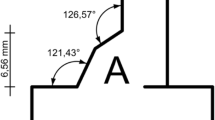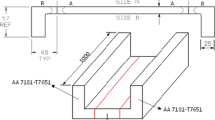Abstract
This paper presents a numerical study to investigate the effects of axial misalignment for the fillet welded cruciform joints using the traction stress method. A parametric study, involving 100 finite element (FE) models, was conducted with plate thickness and misalignments treated as independent parameters. In the parametric study, different fillet weld leg sizes were chosen based on the minimum criteria specified in the New Zealand standard (NZS 3404.1). Normalized shear traction stresses were calculated for each plate thickness and misalignments at different cut planes through the fillet weld. In each model, the maximum normalized shear stress occurred at an angle of 15° to the loading plate, which represents the critical angle for weld failure. Finally, based on the results of the parametric study, an equation for the multiplication factor was proposed for the cruciform joint to obtain the maximum normalized shear traction stress for different misalignments and weld size. The multiplication factor obtained from the FEA matched well with the multiplication factor predicted by the proposed equation, and reliability analysis was conducted to confirm the accuracy of the proposed equation.












Similar content being viewed by others
Abbreviations
- \(\sigma _{ \bot }\) :
-
Normal stress perpendicular to the throat thickness
- \(\sigma _{\parallel }\) :
-
Normal stress parallel to the axis of the weld
- \(\tau _{ \bot }\) :
-
Shear stress (in the plane of the throat) perpendicular to the axis of the weld
- \(\tau _{\parallel }\) :
-
Shear stress (in the plane of the throat) parallel to the axis of the weld
- fu:
-
Nominal ultimate tensile strength of the weaker part joined
- βw :
-
Appropriate correlation factor taken from Table 4.1of EN:1993-1-8 [30]
- F w,Ed :
-
Design value of the weld force per unit length
- F w,Rd :
-
Weld resistance per unit length
- fvwd :
-
Design shear strength of the weld
- fa :
-
Normal stresses, compression or tension, due to axial force or bending moment
- q:
-
Shear stress due to shear force or tension
- fe :
-
Equivalent stress for combined normal and shear
- COV:
-
Co-efficient of vaiation
- FEA:
-
Finite element analysis
- e/t:
-
Ratio for mialignment to plate thickness
- s/t:
-
Ratio for weld size to plate thickness
- Km :
-
Multiplication factor for nomalized traction shear stress
- Km,proposed :
-
Multiplication factor for nomalized traction shear stress for proposed equation
- \({R}_{m}\) :
-
Mean resistance factor
- \({Q}_{m}\) :
-
Mean load factor
- \({V}_{R}\) :
-
Co-efficient of variation of resitance factor
- \({V}_{Q}\) :
-
Co-effieceient of variation of load factor
References
ABAQUS. Analysis user’s manual-version ABAQUS Inc., USA, 2021.
Ahola, A., & Björk, T. (2020). Fatigue strength of misaligned non-load-carrying cruciform joints made of ultra-high-strength steel. Journal of Constructional Steel Research, 175, 106334. https://doi.org/10.1016/j.jcsr.2020.106334
Ahola, A., Skriko, T., & Björk, T. (2020). Fatigue strength assessment of ultra-high-strength steel fillet weld joints using 4R method. Journal of Constructional Steel Research, 167, 105861. https://doi.org/10.1016/j.jcsr.2019.105861
American Institute of Steel Construction (AISC 360), Specifications for structural steel buildings, 2016.
American Iron and Steel Institute (AISI S100), North American Specification for the Design of Cold-formed Steel Structural Members, 2016.
Australia/New Zealand Standards (AS/NZS 3404.1), Steel structure standards. Part.1, 1997.
Australia/New Zealand Standards (AS/ NZS 1554.1), Steel Structure Welding. Part.1 Welding Steel Structure, 2014.
Australia/New Zealand Standards (AS/ NZS 5131.1), Structural Steelwork Fabrication and Erection, Part.1, 2016.
Chandramohan, D. L., Roy, K., Taheri, H., Karpenko, M., Fang, Z., & Lim, J. B. (2022). A state of the art review of fillet welded joints. Materials, 15(24), 8743.
Dong, P. (2001). A structural stress definition and numerical implementation for fatigue analysis of welded joints. International Journal of Fatigue, 23(10), 865–876. https://doi.org/10.1016/S0142-1123(01)00055-X
Dong, P. (2005). Residual stresses and distortions in welded structures: a perspective for engineering applications. Science and Technology of Welding and Joining, 10(4), 389–398. https://doi.org/10.1179/174329305X29465
Dong, P. (2008). Length scale of secondary stresses in fracture and fatigue. International Journal of Pressure Vessels and Piping, 85(3), 128–143. https://doi.org/10.1016/j.ijpvp.2007.10.005
EN 1993-1-9. (2005). Eurocode 3: Design of steel structures–Part 1–9: Fatigue. CEN.
EN 1993-1-8.(2005). Eurocode 3. Design of steel structures–Part 1–8: Design of joints. CEN.
Freitas, M. S. D. R., Brandão, A. L. R., & Alves, A. R. (2018). Reliability analysis of welded and bolted connections in cold-formed steel sections. REM-International Engineering Journal, 71, 371–376.
Fricke, W. (2010). Guideline for the fatigue assessment by notch stress analysis for welded structures. International Institute of welding.
Grilli, D.A., Marshall, K., & Kanvinde, A.M., (2013). A framework for the forensic examination of earthquake-induced steel fracture based on the field failures in the 2011 Christchurch Earthquake. In Forensic Engineering 2012: Gateway to a Safer Tomorrow (pp. 314–323). https://doi.org/10.1061/9780784412640.034
Hobbacher, A. (2006). Problems of effect of weld imperfections on fatigue and their consideration in design codes. Steel Structures, 6, 289–298.
Hobbacher, A. (2016). IIW Recommendations for the fatigue design of welded joints and components (2nd ed.). International Institute of Welding. https://doi.org/10.1007/978-3-319-23757-2
Indian Standard (IS 800), General construction in steel-code of practice. 3rd Revision, New Delhi, India, 2007.
International Organization for Standardization (ISO-670) Welding and allied processes—Classification of Geometric imperfections in metallic materials—Part 1: Fusion welding, 2007.
Kanvinde, A.M., Grilli, D.A., & Marshall, K., (2012). A framework for forensic examination of earthquake induced steel fracture based on the field failures in the 2011 christchurch earthquake. In Proceedings of 15th World Conference on Earthquake Engineering.
Li, C. (2007). Reliability analysis of concentrically loaded fillet welds (Master's thesis @ ualberta).
Liao, X. W., Wang, Y. Q., Wu, J. G., & Shi, Y. J. (2020). Fatigue performance of non-load-carrying cruciform fillet-welded joints at low ambient temperature. Journal of ZheJiang University (engineering Science), 54(10), 2018–2026.
Lie, S. T. (1994). Analysis of fatigue strength on non-load-carrying and load-carrying fillet welded joints. The Journal of Strain Analysis for Engineering Design, 29(4), 243–255. https://doi.org/10.1243/03093247V294243
Lu, H., & Dong, P. (2020). An analytical shear strength model for load-carrying fillet-welded connections incorporating nonlinear effects. Journal of Structural Engineering, 146(3), 04019224. https://doi.org/10.1061/(ASCE)ST.1943-541X.0002532
Lu, H., Dong, P., & Boppudi, S. (2015). Strength analysis of fillet welds under longitudinal and transverse shear conditions. Marine Structures, 43, 87–106. https://doi.org/10.1016/j.marstruc.2015.06.003
Mashiri, F. R., Zhao, X. L., & Grundy, P. (2004a). Stress concentration factors and fatigue failure of welded T-connections in circular hollow sections under in-plane bending. International Journal of Structural Stability and Dynamics, 4(03), 403–422. https://doi.org/10.1142/S021945540400129X
Mashiri, F. R., Zhao, X. L., & Grundy, P. (2004b). Stress concentration factors and fatigue behaviour of welded thin-walled CHS–SHS T-joints under in-plane bending. Engineering Structures, 26(13), 1861–1875. https://doi.org/10.1016/j.engstruct.2004.06.010
Molski, K. L., Tarasiuk, P., & Glinka, G. (2020). Stress concentration at cruciform welded joints under axial and bending loading modes. Welding in the World, 64(11), 1867–1876. https://doi.org/10.1007/s40194-020-00966-4
Nie, C., & Dong, P. (2012). A traction stress-based shear strength definition for fillet welds. The Journal of Strain Analysis for Engineering Design, 47(8), 562–575. https://doi.org/10.1177/0309324712456646
Nuruzzaman, M., Wu, C.Q., & Ojo, O., (2015). Modeling of Welding Joint Using Effective Notch Stress Approach for Misalignment Analysis. In ASME International Mechanical Engineering Congress and Exposition (Vol. 57526, p. V009T12A013). American Society of Mechanical Engineers. https://doi.org/10.1115/IMECE2015-51717
Okazaki, T., Lignos, D. G., Midorikawa, M., Ricles, J. M., & Love, J. (2013). Damage to steel buildings observed after the 2011 Tohoku-Oki earthquake. Earthquake Spectra, 29(1_suppl), 219–243. https://doi.org/10.1193/1.4000124
Remes, H., & Fricke, W. (2014). Influencing factors on fatigue strength of welded thin plates based on structural stress assessment. Welding in the World, 58(6), 915–923. https://doi.org/10.1007/s40194-014-0170-7
Saiprasertkit, K. (2014). Fatigue strength assessment of load-carrying cruciform joints in low-and high-cycle fatigue region based on effective notch strain concept. Welding in the World, 58(4), 455–467. https://doi.org/10.1007/s40194-014-0129-8
SPSS (2020). IBM SPSS statistics for windows, version 270. IBM Corp.
Sugitani, D., & Mochizuki, M. (2013). Experimental study on effects of root gap and fillet size of welds on joint strength. Quarterly Journal of the Japan Welding Society, 31(4), 104s–108s.
Taras, A., & Unterweger, H. (2017). Numerical methods for the fatigue assessment of welded joints: Influence of misalignment and geometric weld imperfections. Engineering Structures and Technologies, 9(1), 9–24. https://doi.org/10.3846/2029882X.2017.1299968
Teh, L.H., & Hancock, G.J., (2002). Strength and behaviour of fillet welded connections in G450 sheet steel.
Teheri Heravi, H. T. (2020). Seismic evaluation of welded moment-resisting connections. Universrsity of Auckland.
Üstündağ, Ö., Fritzsche, A., Avilov, V., Gumenyuk, A., & Rethmeier, M. (2018). Study of gap and misalignment tolerances at hybrid laser arc welding of thick-walled steel with electromagnetic weld pool support system. Procedia CIRP, 74, 757–760. https://doi.org/10.1016/j.jmatprotec.2019.116358
Xing, S., & Dong, P., (2017). A fatigue failure mode transition criterion for sizing load carrying fillet welded connections. In Fatigue and Fracture Test Planning, Test Data Acquisitions and Analysis. ASTM International. https://doi.org/10.1520/STP159820160078
Xing, S., & Dong, P. (2016). An analytical SCF solution method for joint misalignments and application in fatigue test data interpretation. Marine Structures, 50, 143–161. https://doi.org/10.1016/j.marstruc.2016.07.006
Xing, S., Dong, P., & Threstha, A. (2016). Analysis of fatigue failure mode transition in load-carrying fillet-welded connections. Marine Structures, 46, 102–126. https://doi.org/10.1016/j.marstruc.2016.01.001
Xing, S., Dong, P., & Wang, P. (2017). A quantitative weld sizing criterion for fatigue design of load-carrying fillet-welded connections. International Journal of Fatigue, 101, 448–458. https://doi.org/10.1016/j.marstruc.2016.07.006
Yang, Y. P., & Dong, P. (2012). Buckling distortions and mitigation techniques for thin-section structures. Journal of Materials Engineering and Performance, 21(2), 153–160. https://doi.org/10.1007/s11665-011-9928-x
Zong, L., Shi, G., Wang, Y. Q., Li, Z. X., & Ding, Y. (2017). Experimental and numerical investigation on fatigue performance of non-load-carrying fillet welded joints. Journal of Constructional Steel Research, 130, 193–201.
Author information
Authors and Affiliations
Corresponding author
Additional information
Publisher's Note
Springer Nature remains neutral with regard to jurisdictional claims in published maps and institutional affiliations.
Rights and permissions
Springer Nature or its licensor (e.g. a society or other partner) holds exclusive rights to this article under a publishing agreement with the author(s) or other rightsholder(s); author self-archiving of the accepted manuscript version of this article is solely governed by the terms of such publishing agreement and applicable law.
About this article
Cite this article
Paul, B., Fang, Z., Roy, K. et al. Effect of Axial Misalignments in Fillet Welded Cruciform Joint Under Static Loading. Int J Steel Struct 24, 231–245 (2024). https://doi.org/10.1007/s13296-024-00811-0
Received:
Accepted:
Published:
Issue Date:
DOI: https://doi.org/10.1007/s13296-024-00811-0




